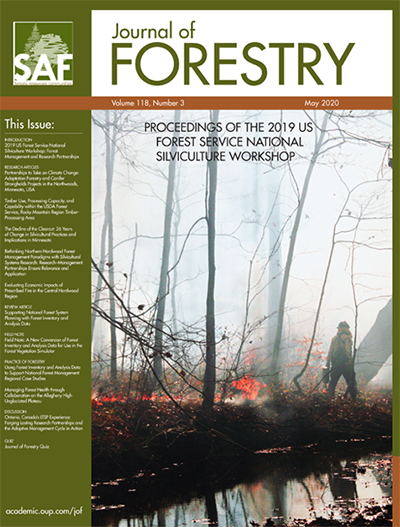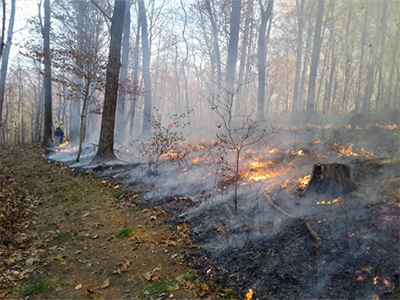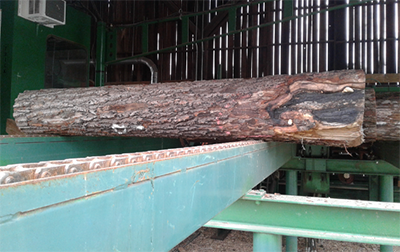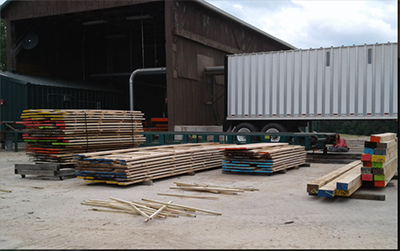Forestry & Natural Resources
Saunders Looks at Impacts of Prescribed Fire on Quality, Economic Value
Prescribed fire is one technique utilized for forest management and tree stand improvement, but what effects does it have on resulting lumber in the treated area and, in turn, what economic impacts could that have long term.

Mike Saunders, associate professor of ecology and natural resources, is the principal investigator on a project with the U.S. Forest Service that aims to answer those questions by determining the effects of prescribed fire on tree and stand quality, resulting potential lumber grade recovery and projected economic value.
The research, which is funded by the Join Fire Science program, also counts Jan Wiedenbeck, Dan Dey and Thomas Schuler of the Forest Service as co-PIs.
The group aims to quantify the relationship between average tree quality and time since inception of a prescribed fire application in a mature stand, to describe the relationship between lumber value recovery and visual fire damage characteristics on standing trees, and then apply those findings from tree-level to stand-level to determine lumber value recovery related to fire history in the oak-dominated stands.
Results could be directly incorporated into the Forest Vegetation Simulator, First Order Fire Effects Model (FOFEM), and other management models to inform cost-benefit analysis on the use of prescribed fire in many eastern forests. The findings also could be of great interest to small woodland owners who may be contemplating the use of prescribed fire to help regenerate their oak-dominated forests.

The Research/Findings
First, the group inventoried 131 mature oak-dominated stands across four national forests in the Central Hardwood Region, selecting stands varied by length of prescribed fire regime. This work resulted in two M.S. theses (Shannon Stanis; Mann) and three peer-reviewed articles (one a cover article for Journal of Forestry).
First, the group inventoried 131 mature oak-dominated stands across four national forests in the Central Hardwood Region, selecting stands varied by length of prescribed fire regime. This work resulted in two M.S. theses (Shannon Stanis; Mann) and three peer-reviewed articles (one a cover article for Journal of Forestry).
Results showed that absolute sawtimber volume losses were highly variable across the national forests, ranging from 0 to 2,269 board foot per acre for stands that had received any burns. This represented 0 to 46.5% of total stand volume. Relative total and butt log (i.e., bottom 16 ft) volume losses increased linearly by +0.9% and +1.1%, respectively, with each burn. More xeric, southern and western aspects did have some effect on volume losses, but the effect was weak until a stand had been burned at least 3 times.
Regionally, the effect of prescribed fire differed by national forest; the Mark Twain National Forest had 5-10x higher average damage than the other three, more eastern, National Forests (10.0% vs 0.9−2.1%).
*Effect of Prescribed Fire on Timber Volume and Grade in the Hoosier National Forest (Forest Science Volume 65, Issue 6, pages 714-724, Published 12/2/2019) – Shannon Stanis, Jan Wiedenbeck, Mike Saunders
*Evaluating Economic Impacts of Prescribed Fire in the Central Hardwood Region (Journal of Forestry, Volume 118, Issue 3, May 2020, Pages 275-288) – David P. Mann, Jan Wiedenbeck, Daniel Dey, Mike Saunders

Second, in order to describe the relationship between lumber value recovery and visual fire damage characteristics on the bole of standing trees, researchers destructively sampled 125 trees in three species groups (white oak, red/scarlet oak, and hickory) from 6-8 stands of differing fire regimes on each of three national forests: the Hoosier National Forest in southern Indiana, the Mark Twain National Forest in Missouri and the Wayne National Forest in Ohio. They milled the butt log of the stems using common techniques and graded the resulting lumber, in order to calculate potential value of fire- damaged timber.
Lastly, to relate lumber value recovery value to the fire history for oak-dominated stands, researchers will apply the tree-level lumber value relationships developed in the second objective to the stand-level inventories gathered in first objective. This will give stand-level valuations of damage as it relates to length and severity of a prescribed fire regime.
Thus far, results have shown that prescribed fire caused, in absolute terms, 0 - $273 per acre of loss in stumpage value (as estimated from regional prices from 2014-2018).  In relative terms, this was up to 57% of stand stumpage value, but that level of damage was limited to a few stands in the Mark Twain National Forests. Stands in all other National Forests had relative losses of less than 10%. Relative value loss increased linearly by +1.5% with each burn; more xeric, southern and western aspects increased value loss an additional 1.5%. The effect of prescribed fire differed by national forest; the Mark Twain National Forest had 6-16x higher average damage than the other three, more eastern, National Forests (15.5% vs 1.0−2.8%).
In relative terms, this was up to 57% of stand stumpage value, but that level of damage was limited to a few stands in the Mark Twain National Forests. Stands in all other National Forests had relative losses of less than 10%. Relative value loss increased linearly by +1.5% with each burn; more xeric, southern and western aspects increased value loss an additional 1.5%. The effect of prescribed fire differed by national forest; the Mark Twain National Forest had 6-16x higher average damage than the other three, more eastern, National Forests (15.5% vs 1.0−2.8%).
 In relative terms, this was up to 57% of stand stumpage value, but that level of damage was limited to a few stands in the Mark Twain National Forests. Stands in all other National Forests had relative losses of less than 10%. Relative value loss increased linearly by +1.5% with each burn; more xeric, southern and western aspects increased value loss an additional 1.5%. The effect of prescribed fire differed by national forest; the Mark Twain National Forest had 6-16x higher average damage than the other three, more eastern, National Forests (15.5% vs 1.0−2.8%).
In relative terms, this was up to 57% of stand stumpage value, but that level of damage was limited to a few stands in the Mark Twain National Forests. Stands in all other National Forests had relative losses of less than 10%. Relative value loss increased linearly by +1.5% with each burn; more xeric, southern and western aspects increased value loss an additional 1.5%. The effect of prescribed fire differed by national forest; the Mark Twain National Forest had 6-16x higher average damage than the other three, more eastern, National Forests (15.5% vs 1.0−2.8%).Recently, the U.S. Forest Service highlighted findings from the second objective of the project in its newsletter: Collaborative Oak Management in Southeast Ohio
For forest managers in the oak-dominated ecosystems of the eastern United States, prescribed fire is an important tool in perpetuating oak  as well as in achieving wildlife habitat improvement, post-harvest site preparation, oak and pine regeneration, and range allotments. However, concern about reducing the value of overstory oak makes some managers wary of using fire as a management tool.
as well as in achieving wildlife habitat improvement, post-harvest site preparation, oak and pine regeneration, and range allotments. However, concern about reducing the value of overstory oak makes some managers wary of using fire as a management tool.
 as well as in achieving wildlife habitat improvement, post-harvest site preparation, oak and pine regeneration, and range allotments. However, concern about reducing the value of overstory oak makes some managers wary of using fire as a management tool.
as well as in achieving wildlife habitat improvement, post-harvest site preparation, oak and pine regeneration, and range allotments. However, concern about reducing the value of overstory oak makes some managers wary of using fire as a management tool.Northern Research Station scientists are part of an Interagency Forestry Team in Ohio that is working to allay concern about prescribed fire with research addressing questions about fire and timber quality. Alongside the Ohio Department of Natural Resources, Purdue University, and the Wayne, Mark Twain, Hoosier, and Daniel Boone National Forests, Northern Research Station scientists are working to establish how prescribed fire affects timber volume, grade and value.
This summer, a team of researchers, foresters and ecologists convened at the Zaleski Sawmill in Ohio, one of the few state-operated sawmills in the country, to evaluate logs, saw the logs into lumber, and evaluate and grade timber from the Mark Twain and Wayne National Forests. The project involved many moving parts that were largely coordinated by members of the Ohio Interagency Forestry Team. Some of these moving parts included: approvals; harvesting, skidding, and hauling logistics and operations; log delivery and sorting at the Zaleski State Forest’s log yard; laser scanning; log bucking; marking logs for tracking; defect identification and measurement; sawing and edging more than 100 logs; grading the lumber recovered; and stacking the lumber for quality drying.






